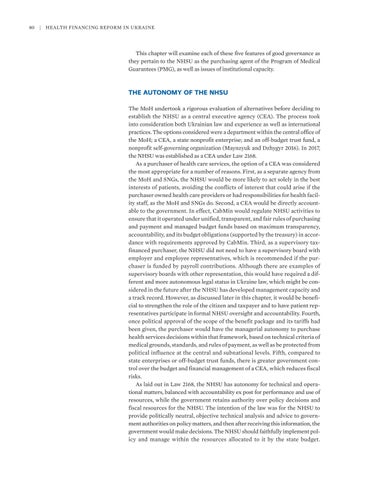80
| Health Financing Reform in Ukraine
This chapter will examine each of these five features of good governance as they pertain to the NHSU as the purchasing agent of the Program of Medical Guarantees (PMG), as well as issues of institutional capacity.
THE AUTONOMY OF THE NHSU The MoH undertook a rigorous evaluation of alternatives before deciding to establish the NHSU as a central executive agency (CEA). The process took into consideration both Ukrainian law and experience as well as international practices. The options considered were a department within the central office of the MoH; a CEA, a state nonprofit enterprise; and an off-budget trust fund, a nonprofit self-governing organization (Maynzyuk and Dzhygyr 2016). In 2017, the NHSU was established as a CEA under Law 2168. As a purchaser of health care services, the option of a CEA was considered the most appropriate for a number of reasons. First, as a separate agency from the MoH and SNGs, the NHSU would be more likely to act solely in the best interests of patients, avoiding the conflicts of interest that could arise if the purchaser owned health care providers or had responsibilities for health facility staff, as the MoH and SNGs do. Second, a CEA would be directly accountable to the government. In effect, CabMin would regulate NHSU activities to ensure that it operated under unified, transparent, and fair rules of purchasing and payment and managed budget funds based on maximum transparency, accountability, and its budget obligations (supported by the treasury) in accordance with requirements approved by CabMin. Third, as a supervisory tax- financed purchaser, the NHSU did not need to have a supervisory board with employer and employee representatives, which is recommended if the purchaser is funded by payroll contributions. Although there are examples of supervisory boards with other representation, this would have required a different and more autonomous legal status in Ukraine law, which might be considered in the future after the NHSU has developed management capacity and a track record. However, as discussed later in this chapter, it would be beneficial to strengthen the role of the citizen and taxpayer and to have patient representatives participate in formal NHSU oversight and accountability. Fourth, once political approval of the scope of the benefit package and its tariffs had been given, the purchaser would have the managerial autonomy to purchase health services decisions within that framework, based on technical criteria of medical grounds, standards, and rules of payment, as well as be protected from political influence at the central and subnational levels. Fifth, compared to state enterprises or off-budget trust funds, there is greater government control over the budget and financial management of a CEA, which reduces fiscal risks. As laid out in Law 2168, the NHSU has autonomy for technical and operational matters, balanced with accountability ex post for performance and use of resources, while the government retains authority over policy decisions and fiscal resources for the NHSU. The intention of the law was for the NHSU to provide politically neutral, objective technical analysis and advice to government authorities on policy matters, and then after receiving this information, the government would make decisions. The NHSU should faithfully implement policy and manage within the resources allocated to it by the state budget.

